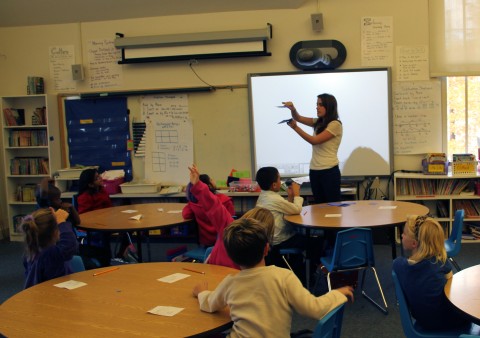
Photo by Julie McMahon, Creative Director
Sarah Holland ’11 wakes up every weekday at 6:30 AM. While most of Connecticut College sleeps off a late study session at the library or the indigestion from an ill advised slice of Cro pizza after bar night, Sarah showers, gets dressed and eats breakfast. She arrives in her classroom around 7:45 AM. This classroom is not in the attic of Fanning or the basement of Olin: it is a bright, cheery kindergarten classroom at the Regional Multicultural School in New London.
Sarah is student teaching this semester, as part of the teacher certification program at Connecticut College. After working on preparations with the teacher, Sarah’s students arrive at 8:30 AM. While the school day lasts until 3:00 PM, having to prepare for the following day ensures she will head back to Conn at 4:00 PM at the earliest and 7:00 PM at the latest.
All majors require a large portion of classwork to be completed outside of classroom time, whether it be an essay for an English class, studio time for a fine arts class or lab work for a science class. However, there is nothing comparable to the professional experience gained by those in the student teaching program.
Preparation for a career in education through the student-teaching program involves far more than just classroom time, Holland says. “We have two seminars that are paired with our student teaching: one focusing on practice and the other focusing on theory, specifically critical pedagogy, and applying it in our classrooms.”
Despite the five day per week commitment in the classroom and the two seminars back at Connecticut College, there are still more steps that one must take to become a certified teacher, depending on the area of focus. Danielle Green ’11, who has been teaching both band classes and music theory classes at Lyme-Old Lyme High School in Old Lyme, CT, explains that “to become a music teacher, one must fulfill all of the State of Connecticut’s general education requirements, as well as taking music methods classes in woodwinds, brass, percussion, vocal, strings, and piano,” noting that all this must occur prior to beginning student teaching.” If certified in the State of Connecticut, Green would be eligible to teach music at any level, from kindergarten through twelfth grade, though she has chosen secondary education for the time being.
Not all student teachers plan to jump right into a public school teaching career. Holland lists “taking some time off to be a ski bum out west and teach skiing (preferably to people with disabilities), living abroad and teaching English for a couple of years, and ultimately earning my master’s degree in special education in order to work in an inclusive setting with children with disabilities” as part of her post-graduation plans.
Undoubtedly, these students are as open to a wide variety of opportunities and experiences as those in every other area of study. Lily Holland ’11, who teaches second grade at the Regional Cultural Magnet School in New London, reflects on the variety of options still open to those who will complete the certificate program. “I had an internship this summer at a non-profit that was more centered around policy and I loved that too. I know I want to be in the sphere of education and I will teach at some point, but I hope I’m not limited to just that.”
The education certification program is not something that can be taken up at the last minute. The crucial advice from these seniors in the program seems to be getting involved during freshman year and deciding to make a full commitment or none at all. “I’ve been part of the certificate program since spring of my freshman year,” said Sarah. “If students think they are interested in getting certified, they should start early and plan ahead!”
The large time commitment does indeed take a toll on student teachers. “Student teaching requires a lot of discipline, especially waking up so early in the morning,” said Green. Sarah describes the challenges of maintaining a college social life while student teaching. When she does have the time to hang out with friends, “I am typically too exhausted to be any fun anyway,” she said. However, Sarah, Danielle and Lily all have had positive experiences in the program and all seem to feel that it has been well worth their time and energy.
There is a fun aspect to getting to spend a significant amount of time in a school environment. “One thing that I can definitely count on I that something funny occurs almost every day, especially when it comes to over 100 high school kids and band instruments,” said Green. Sarah’s class, after learning about the letter D, experienced a pleasant surprise. “My cooperating teacher and I asked a teacher at the school to bring her dog into our classroom. The kids freaked out, they were blown away!” What student teachers are guaranteed is that every day at work is different.
Lily mentioned a time when a student inquired if she slept on a table at night. Lily said, “When I asked what on earth he meant, he explained that since I ‘lived at school’ he figured I probably didn’t have a bed. So I had to explain to him that I live at college which is different from elementary school.” While Lily was undoubtedly amused by the question, perhaps the student was more intuitive than imaginative; after thinking about the countless hours that go into being student teachers—on top of the burdens associated with being students themselves—to say that this dedicated group of teachers-in-training ‘live at school’ does not seem so silly after all.








